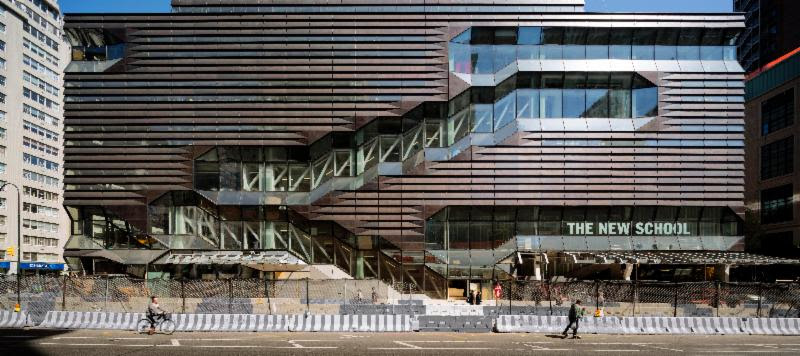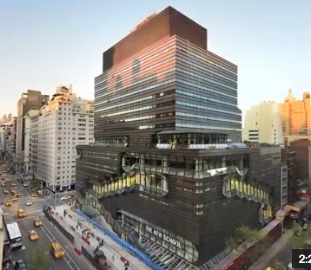A series of events will be held this week to mark the official opening of The New School's University Center, a striking new landmark for the school designed by Skidmore, Owings & Merrill LLP (SOM). The week-long celebration will include an opening ceremony tomorrow, January 23rd, and an open house for students, alumni, and neighbors on January 25th.
Located at the intersection of Fifth Avenue and 14th Street, the 375,000-square-foot center reflects and reinforces the experimental nature of The New School and creates a dialogue between the campus community, the local neighborhood, and the city.
The 16-story building houses design studios, laboratories, interdisciplinary classrooms, the main university library, a nine-floor student residence, an 800-seat auditorium, a café, and flexible academic and social spaces for student activity.
"The University Center transforms the traditional university environment," explains Roger Duffy, FAIA, Design Partner at SOM. "Rather than compartmentalizing living and learning spaces, we strategically stacked these functions to create a vertical campus that supports the kind of interdisciplinary learning that has defined The New School since its founding."
Connections between classrooms, studios, library, cafés, auditorium, and student residences take the form of stacked staircases and "sky quads" that facilitate the chance encounters vital to the cultivation of discussion and debate at The New School.
"The University Center boldly embodies The New School's commitment to creativity, innovation, challenging to the status quo, and education through social engagement," says David Van Zandt, president of The New School. "With its collaborative learning spaces, state-of-the-art performance spaces and studios, and striking exteriors, the University Center uniquely encourages experimentation, exchange, and engagement with our city and our world."
A New Kind of Urban Campus
With its 230,000-square-foot, seven-story campus center (located in the building's base) and 130,000-square-foot residential tower, the University Center reimagines the organizing elements of a traditional campus, from quads to classrooms and living quarters. Vertical, horizontal, and diagonal campus pathways work together to facilitate movement through the building, while increasing opportunities for interaction among students and faculty from across the university. Academic spaces are flexible and easily adaptable, and can be renovated or reconfigured with no impact on power, data, or lighting to meet changing needs.
This innovative interior organization is expressed in the exterior of the building. Tightly woven, purpose-built spaces clad in hand-finished brass shingles contrast with the open connective tissue of the stairs and quads visible through a glazed skin. The exterior mediates between the cast-iron façades of the Ladies' Mile Historic District to the north and the brownstones of the Greenwich Village Historic District to the south and west.
Pathways to Discussion and Debate
The University Center's system of double stairways plays a critical role in the life of the building; it works in conjunction with skip-stop elevators to move large numbers of students vertically through the building. Stacked one above the other, the fire stair is designed for quick circulation, while the broader, open "communicating stair" allows for travel between floors at a more leisurely pace. With faceted walls clad in glass-fiber-reinforced concrete panels, the high-use stairways are a place for chance meetings between students and faculty, and encourage social interaction and interdisciplinary exchange.
Circulation paths that weave vertically, horizontally and diagonally through the building lead into and activate sky quads-interactive spaces that also orient users due to their adjacency to stairways and corridors. Like the "local" and "express" stairs that link them, the sky quads are intended to perform as social spaces, promoting formal and informal encounters between students and faculty, as well as supporting academic and leisure activities. These interactive spaces include student lounge areas, student resource centers with adjacent meeting rooms, study areas, cafés, and pin-up spaces for design studios.
To avoid crowded conditions and delays during class-change times in this vertical campus, peak elevator demand is mitigated through the combination of the intuitive system of stairways and a skip-stop elevator system. During peak times, the elevators stop at floors one, four, and six, and stairs are utilized to access the intermediate floors, while at off-peak times, the elevators stop at all floors.
Active Design Features
A central stair is the principle design feature in the University Center-a focal point both inside and outside the building. These stairs are intended as the principal means of circulation through the building for the physically able. Through the use of clerestory windows in hallways and on the façade, the University Center provides for daylighting along paths of travel, and the design is organized to encourage walking between destinations, as well as spaces for social interaction.
The building provides bike storage rooms and showers to encourage cycling, walking, and running between home and school. The building was recognized by Former Mayor Michael Bloomberg as a model of the successful implementation of the "active design" strategies that are part of New York City's anti-obesity and health initiatives.
A Commitment to Sustainability and Energy Efficiency
Designed to meet LEED Gold certification from the US Green Building Council, the University Center will set the New York City standard for green technology and building practices with super-efficient LED lights, occupancy sensors, a 265-kilowatt cogeneration plant, and sustainably sourced materials.
Envisioned as a model of energy efficiency, carbon reduction, and sustainability, the building anticipates 31 percent energy savings over a base-case school. Both passive and high-tech solutions increase energy efficiency. The envelope of the building is limited to 35 percent glass, to limit solar heat gain while still optimizing interior daylighting. The shingled cladding shades the windows up to 20 percent during daylight hours. An ice-storage system, located in the second basement, uses electricity from the power grid during off-peak times to freeze water in a series of chambers; the ice melts during the day, reducing consumption during peak times.
Heat recovery wheels gather heat from exhaust air and help heat supply air, saving energy. A green roof, funded in part by the New York City Department of Environmental Protection, mitigates the heat-island effect, as well as storm-water runoff, capturing water for both gray-and black-water treatment facilities in the building. Waterless urinals contribute to potable-water conservation. Composting is employed with an in-vessel composter in the cafeteria.
The building will serve as a living element of the curriculum, providing on-site training to the next generation of green leaders to students in environmental studies, sustainability management, and urban design. Design elements that demonstrate architectural, structural, mechanical and green building strategies will be visible through signage and working exhibits. Back-of-the-house systems will be transformed into instructional spaces for New School students and facilities staff, as well as for professional organizations and unions, who are expected to use the building for hands-on training.
Student Resources
A co-ed residential tower for more than 600 students occupies floors eight through 16 of the University Center. An amenity space on the lower level is accessible only by residents and consists of a large common room, art studios, an exercise facility with gym equipment, soundproof music practice rooms, a study hall, bicycle storage area, mailroom, and laundry room. The University Center has three dining areas: a 280-seat cafeteria on the second floor, an 80-seat library café on the seventh floor, and a 60-seat event café on the lower level off the entrance lobby and auditorium.
About Skidmore, Owings & Merrill LLP
Skidmore, Owings & Merrill LLP (SOM) is one of the leading architecture, interior design, engineering, and urban-planning firms in the world, with a 75-year reputation for design excellence and a portfolio that includes some of the most important architectural accomplishments of the 20th and 21st centuries. Since its inception, SOM has been a leader in the research and development of specialized technologies, new processes and innovative ideas, many of which have had a palpable and lasting impact on the design profession and the physical environment.
The firm's longstanding leadership in design and building technology has been honored with more than 1,700 awards for quality, innovation, and management. The American Institute of Architects has recognized SOM twice with its highest honor, the Architecture Firm Award-in 1962 and again in 1996. The firm maintains offices in New York, Chicago, San Francisco, Los Angeles, Washington, D.C., London, Hong Kong, Shanghai, Mumbai, and Abu Dhabi.
About The New School
Founded in 1919, The New School was born out of principles of academic freedom, tolerance, and experimentation. Committed to social engagement, The New School today remains in the vanguard of innovation in higher education, with more than 10,000 undergraduate and graduate students challenging the status quo in design and the social sciences, liberal arts, management, the arts, and media. The New School welcomes thousands of adult learners annually for continuing education courses and calendar of lectures, screenings, readings, and concerts. Through its online learning portals, research institutes, and international partnerships, The New School maintains a global presence. Learn more at www.newschool.edu.
Related Stories
Shopping Centers | Mar 7, 2024
How shopping centers can foster strong community connections
In today's retail landscape, shopping centers are evolving beyond mere shopping destinations to become vibrant hubs of community life. Here are three strategies from Nadel Architecture + Planning for creating strong local connections.
Market Data | Mar 6, 2024
Nonresidential construction spending slips 0.4% in January
National nonresidential construction spending decreased 0.4% in January, according to an Associated Builders and Contractors analysis of data published today by the U.S. Census Bureau. On a seasonally adjusted annualized basis, nonresidential spending totaled $1.190 trillion.
MFPRO+ Research | Mar 6, 2024
Top 10 trends in senior living facilities for 2024
The 65-and-over population is growing faster than any other age group. Architects, engineers, and contractors are coming up with creative senior housing solutions to better serve this burgeoning cohort.
Architects | Mar 5, 2024
Riken Yamamoto wins 2024 Pritzker Architecture Prize
The Pritzker Architecture Prize announces Riken Yamamoto, of Yokohama, Japan, as the 2024 Laureate of the Pritzker Architecture Prize, the award that is regarded internationally as architecture’s highest honor.
Office Buildings | Mar 5, 2024
Former McDonald’s headquarters transformed into modern office building for Ace Hardware
In Oak Brook, Ill., about 15 miles west of downtown Chicago, McDonald’s former corporate headquarters has been transformed into a modern office building for its new tenant, Ace Hardware. Now for the first time, Ace Hardware can bring 1,700 employees from three facilities under one roof.
Green | Mar 5, 2024
New York City’s Green Economy Action Plan aims for building decarbonization
New York City’s recently revealed Green Economy Action Plan includes the goals of the decarbonization of buildings and developing a renewable energy system. The ambitious plan includes enabling low-carbon alternatives in the transportation sector and boosting green industries, aiming to create more than 12,000 green economy apprenticeships by 2040.
Lighting | Mar 4, 2024
Illuminating your path to energy efficiency
Design Collaborative's Kelsey Rowe, PE, CLD, shares some tools, resources, and next steps to guide you through the process of lighting design.
MFPRO+ News | Mar 1, 2024
Housing affordability, speed of construction are top of mind for multifamily architecture and construction firms
The 2023 Multifamily Giants get creative to solve the affordability crisis, while helping their developer clients build faster and more economically.
Multifamily Housing | Feb 29, 2024
Manny Gonzalez, FAIA, inducted into Best in American Living Awards Hall of Fame
Manny Gonzalez, FAIA, has been inducted into the BALA Hall of Fame.
K-12 Schools | Feb 29, 2024
Average age of U.S. school buildings is just under 50 years
The average age of a main instructional school building in the United States is 49 years, according to a survey by the National Center for Education Statistics (NCES). About 38% of schools were built before 1970. Roughly half of the schools surveyed have undergone a major building renovation or addition.




















